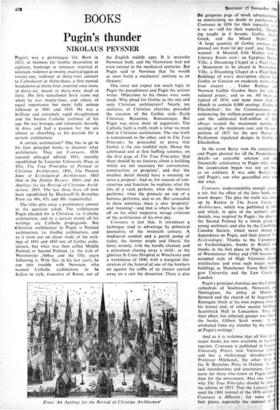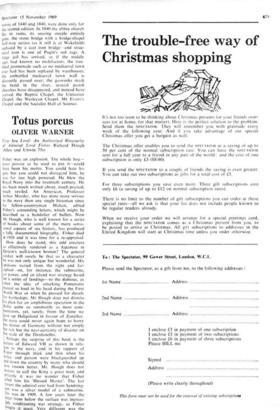BOOKS Pugin's thunder
NIKOLAUS PEVSNER
Pugin's was a picturesque life. Born in 1812, in business for Gothic decoration at eighteen, bankrupt at nineteen, married at nineteen, widower at twenty, married again at twenty-one, widower at thirty-two, convert to Catholicism at thirty-three, a first mental breakdown at thirty-four, married once more at thirty-six, insane at thirty-nine, dead at forty. His first sensational book came out when he was twenty-four, and others of equal importance but more fully serious followed in 1841 and 1843. He was a brilliant and extremely rapid draughtsman and the busiest Catholic architect qf his age. He was brusque and vehement, slovenly in dress and had a passion for the sea almost as absorbing as his passion for a certain architecture.
A certain architecture? One has to go to his four principal books to discover what architecture. They are Contrasts, 1836 (second enlarged edition 1841, recently republished by Leicester University Press at 45s), The True Principles of Pointed or Christian Architecture, 1841, The Present State of Ecclesiastical Architecture, 1843 (but in the Dublin Review, 1841) and An Apology for the Revival of Christian Archi- tecture, 1843. The last three have all now been republished by Blackwell/St Barnabas Press (at 60s, 65s and 60s respectively).
The titles give away a preliminary answer to the question asked. The architecture Pugin pleaded for is Christian, i.e. Catholic architecture, and to a certain extent all his writings are Catholic propaganda. But Christian architecture to Pugin is Pointed architecture, i.e. Gothic architecture, and as it turns out on closer study of the writ- ings of 1841 and 1843 not all Gothic archi- tecture, but what was then called Middle Pointed or Second Pointed, i.e. the style of Westminster ,Abbey and the fifty years following it. With this, in his last years, he ran into trouble with Newman, who wanted Catholic architecture to be Italian in style, evocative of Rome, not of the English middle ages. It is oratories Newman built, and the Oratorians had not even existed in the mediaeval centuries. But Pugin said to Newman that 'he would as soon build a mechanics' institute as an Oratory'.
One must not expect too much logic in Pugin the pamphleteer and Pugin the serious writer. Objections to his theses were soon made. Why plead for Gothic as the one and only Christian architecture? Nearly ten centuries of Christian churches preceded the creation of the Gothic style—Early Christian, Byzantine, Romanesque. But Pugin was never short of arguments. The Catholic faith is trait, truth is what we must find in Christian architecture. The one truth is tantamount to the other, and in The True Principles he proceeded to prove that Gothic is the one truthful style. Hence the celebrated and at first baffling sentence, on the first page of The True Principles, 'that there should be no features about a building which are not necessary for convenience, construction, or propriety', and that 'the smallest detail should have a meaning or serve a purpose'. And so, for reasons of con- struction and function, he explains what the ribs of a vault perform, what the buttress performs, what the pinnacle on top of a buttress performs, and so on. But concealed in these sentences there is also 'propriety' and 'meaning'—and that is where he can be off on his other trajective, savage criticism of the architecture of his own day.
Contrasts is just that. It introduces a technique used to advantage by polemica1. journalists of the twentieth century. A mediaeval conduit and a parish pump of today, the former ample and liberal, the latter miserly, with the handle chained, and a policeman chasing away a child ; or the glorious St Cross Hospital at Winchester and a workhouse of 1840, with a marginal illu- stration of the funeral of one of the brothers set against the coffin of an inmate carried away on a cart for dissection. There is also
From 'An Apology for the Revival of Christian Architecture'
the gorgeous page of mock advertisements, as entertaining no doubt to purchasers 0 Contrasts in 1836 for their topicality as it is to us—still for their topicality. 'Design. ing taught in 6 lessons, Gothic, Severe Greek, and the Mixed Styles', and 'A large quantity of Gothic cornices just pressed out from 6d per yard', and 'Designs wanted: A Moorish Fish Market uith a Literary Room over ; an Egyptian Marine Villa; a Dissenting Chapel in a Plain a Monument to be placed in Westminste Villa; a Dissenting Chapel in a Plain Style Buildings of every description altered int Gothic or Grecian on moderate terms; Ca Iron tracery . . . Tudor Railings an Norman Gothic Garden Seats for sale reduced prices', and so on. All these a typical of 1834, and none more than church to contain 8,000 seatings, Gothic o Elizabethan'; for the Commissioners ad ministering the million-pound grant of 181 and the additional half-million of l82 always wanted the maximum number 43 seatings at the minimum cost, and the corn petition of 1855 for the new Houses 0 Parliament stipulated designs in Gothic o Elizabethan.
In the event Barry won the competitio and Pugin ghosted for all the Perpendicula details—an amicable relation and o financially satisfactory to Pugin who, whe the cooperation began was not yet bus as an architect. It was only Barry's so and Pugin's son who quarrelled over wh did what.
Contrasts, understandably enough, cause a stir, but the effect of the later books ua much deeper. The plea for truth was take up by Ruskin in The Seven Lamps Architecture, which was published in 184 and which, in spite of the author's shuti denials, was inspired by Pugin ; the plea fo the Second Pointed by a whole group o young architects and also by the Cambridg Camden Society, which never denied it dependence on Pugin, and their journal Ti Ecclesiologist. Thanks to the Camdenian or Ecclesiologists, thanks to Ruskin an thanks in the first place to Pugin, the sty- of Westminster Abbey and 1300 became t accepted style of High Victorian chum architecture and even such major secul buildings as Manchester Town Hall, Gla gow University and the Law Courts London.
Pugin's principal churches are the Cathol cathedrals of Southwark, Newcastle an Nottingham, the abbey of Mount Bernard and the church of St Augustine Ramsgate (built at his own expense close I his house) and, of other secular buildin Scarisbrick Hall in Lancashire. They h their effect, but infinitely greater was that the books. Gilbert Scott wrote: 'I awakened from my slumber by the thin" of Pugin's writings.'
And so it is welcome that all four of major books- are now available in facsim reprints. Contrasts is published in Leices University Press's new Victorian Libra and has a twelve-page introduction Professor Hitchcock, the other three the St Barnabas Press in Oxford. As lack introductions and annotation, they more for those who know of Pugin alrea than for the newcomers. Also one 'O' why The True Principles should be done the edition of 1853. That the Leicester Pr used the 1841 instead of the 1836 edition Contrasts is different ; for some of best plates, especially the contrast of towns of 1440 and 1840, were done only for the second edition. In 1840 the abbey church lies in ruins, its soaring steeple entirely gone, the stone bridge with a bridge-chapel half-way across (as it still is at Wakefield) replaced by a cast iron bridge—and struc- tural iron is one of Pugin's red rags. A large jail has arrived; as if the middle ages had known no malefactors, the tree- Hoed promenade such as no mediaeval town ever had has been replaced by warehouses, the embattled mediaeval town wall is discreetly passed over; the gasworks mark the bend in the river, several parish churches have disappeared, and instead have arrived the Baptist Chapel, the Unitarian Chapel, the Wesleyan Chapel, Mr Evans's Chapel and the Socialist Hall of Science.







































 Previous page
Previous page